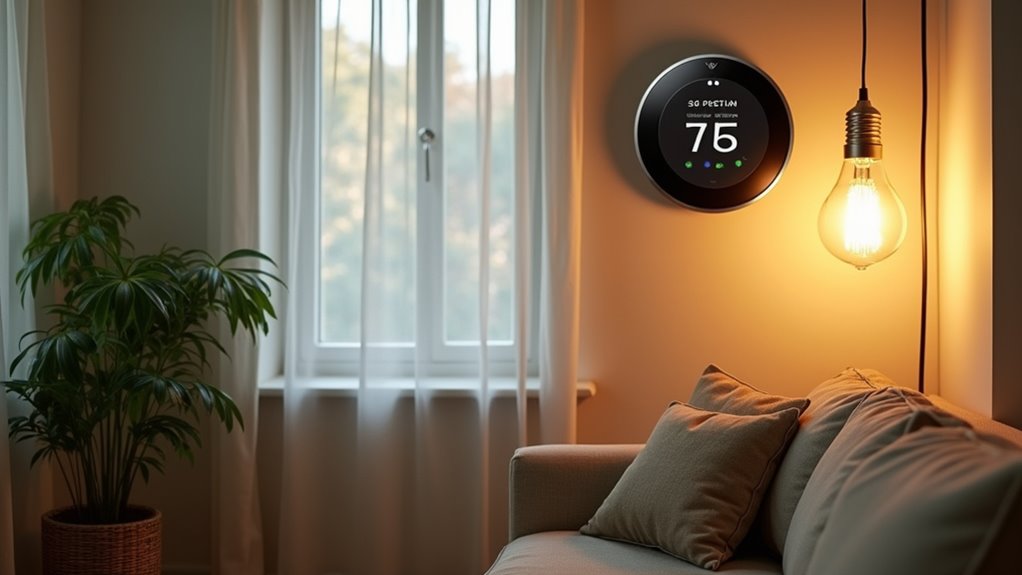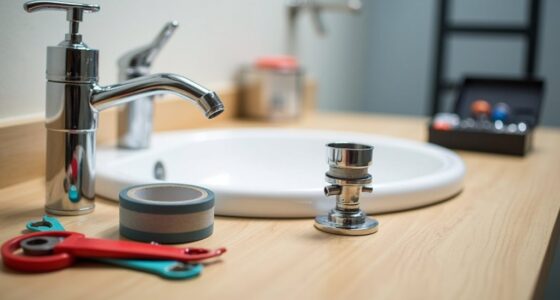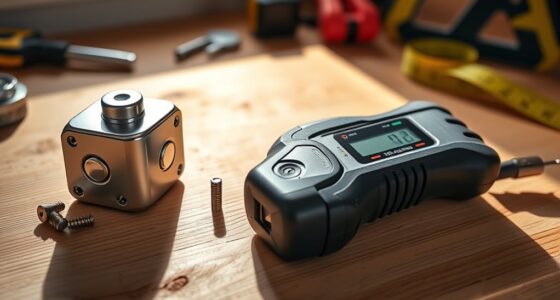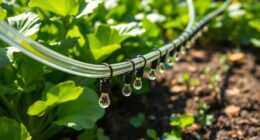To save energy in every room of your house, start by choosing Energy Star appliances in the kitchen and using small appliances when possible. In the bathroom, install low-flow fixtures and take shorter showers. For the bedroom, optimize your thermostat and use thermal curtains. Wash clothes in cold water and clean your dryer lint trap regularly. Seal gaps in your garage, and consider smart technology for efficient energy management. Keep going to discover even more tips for optimizing your home’s energy use!
Key Takeaways
- Use Energy Star-rated appliances in kitchens and laundry rooms to reduce energy consumption by 10-50% compared to standard models.
- Install low-flow fixtures in bathrooms to cut water usage by up to 50%, saving energy on heating water.
- Wash clothes in cold water and line-dry when possible to save on heating costs and reduce overall energy use.
- Optimize thermostat settings and use thermal curtains in bedrooms to maintain comfort while lowering heating and cooling expenses.
- Implement energy-efficient lighting solutions throughout the house, such as LED bulbs, to decrease energy usage by up to 75%.
Energy Efficiency in the Kitchen
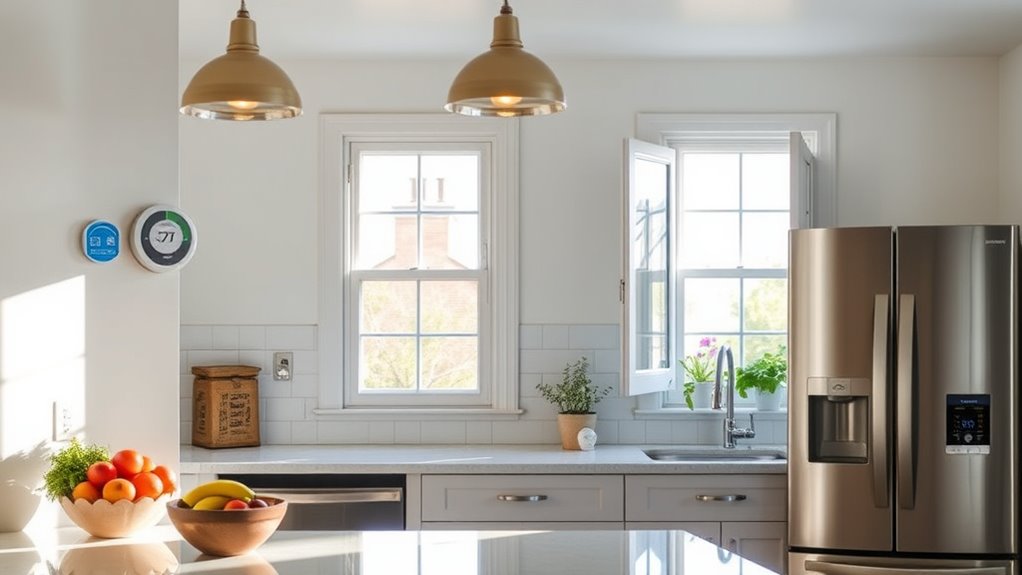
Have you ever wondered how much energy your kitchen really uses? It’s often the second-largest energy consumer in your home, right after HVAC systems.
To improve energy efficiency, opt for Energy Star-rated appliances; they can cut energy costs by 10-50% compared to standard ones. Energy-efficient models can also reduce electricity costs significantly. Additionally, using air purifiers with high energy efficiency ratings can help maintain good air quality without excessively increasing energy consumption. Implementing standard operating procedures in your kitchen can also enhance energy efficiency by ensuring appliances are used optimally.
Don’t forget to regularly clean your refrigerator condenser coils—dirty coils can raise energy consumption by up to 30%.
When cooking, prioritize small appliances like microwaves and toaster ovens, as they typically use less energy than traditional ovens.
And remember, keep your oven door closed! Each time you open it, you lose 25-30 degrees of heat, which not only increases cooking time but also boosts energy use.
For an even greater impact on your energy bills, consider investing in energy-efficient kitchen appliances, which can significantly reduce overall energy consumption.
Save energy and money with these simple tips!
Water and Energy Conservation in the Bathroom
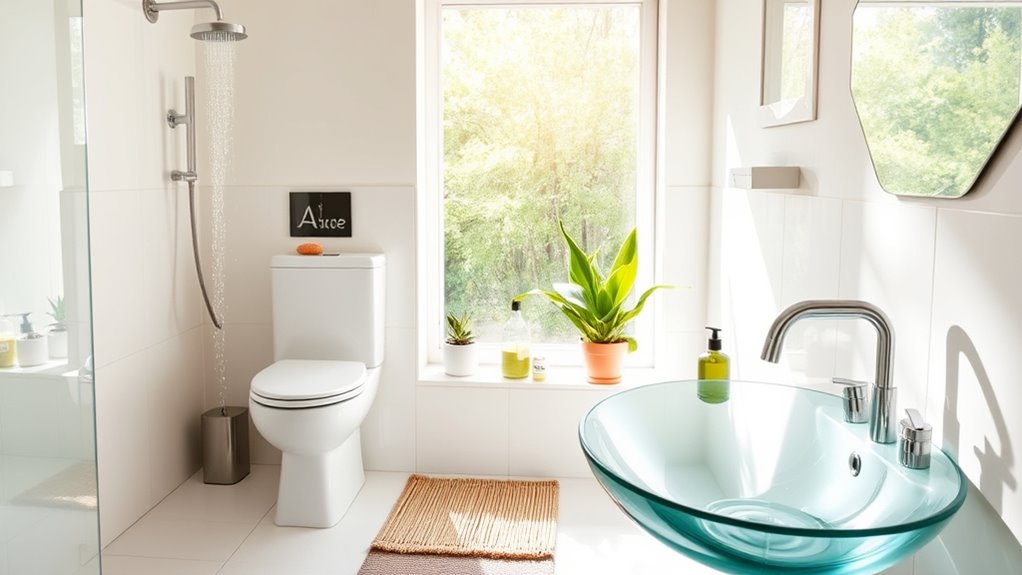
In the bathroom, you can make a big impact on both water and energy conservation by installing low-flow fixtures. These simple changes not only cut down on water usage but also lower the energy needed for heating that water. Plus, being mindful of how long you shower and turning off the tap when brushing your teeth can lead to even more savings. Additionally, ensuring proper venting techniques during installation can help maintain energy efficiency throughout your home. Consider investing in eco-friendly toilets that significantly reduce water consumption and enhance overall bathroom sustainability. Moreover, adopting the one in, one out rule can help you manage bathroom products effectively, preventing clutter and supporting a more organized and efficient space. Furthermore, using energy-efficient heat pumps can further reduce energy consumption and improve overall climate control in your home.
Low-Flow Fixtures
Utilizing low-flow fixtures in your bathroom can markedly reduce both water and energy usage.
By making a few simple changes, you can save on utility bills while promoting sustainability.
Here are some benefits of low-flow fixtures:
- Low-flow showerheads can cut water usage by up to 50%, saving energy for heating. Additionally, improving indoor air quality with air purifiers can further enhance your overall comfort.
- Faucets and aerators reduce flow to less than 2.5 gallons per minute without compromising performance.
- Low-flow toilets save over 13,000 gallons of water annually, lowering bills markedly.
- These fixtures lessen the load on hot water systems, potentially reducing energy costs by 25-60%.
- Many fixtures meet or exceed EPA WaterSense standards, ensuring effective performance. Regularly incorporating health and wellness benefits from a clean environment can further enhance your overall quality of life.
- Additionally, using low-flow fixtures contributes to sustainable living practices that benefit both the environment and your home.
Switching to low-flow fixtures is a smart move for your home.
Efficient Water Heating
Switching to low-flow fixtures not only conserves water but also complements your efforts in efficient water heating.
You can save energy by taking shorter showers and lowering your water heater temperature to 120°F. This simple adjustment can reduce heating costs by 6-10% for every 10 degrees you lower it. Additionally, using best home security systems can help protect your home while you’re away, ensuring peace of mind as you focus on energy efficiency. Furthermore, conducting a home energy audit can reveal additional opportunities for improving energy use.
Remember, hot water is the second-largest energy user in your home, so optimizing its use is essential. Additionally, pet therapy can provide companionship, reducing feelings of isolation, which may encourage more efficient and mindful usage of water and energy.
Insulating your hot water pipes minimizes heat loss, ensuring hot water reaches your taps faster while using less energy.
Additionally, flushing your hot water heater regularly removes sediment buildup, enhancing its efficiency and prolonging its lifespan.
Implementing strategies like improving indoor air quality through proper ventilation can further enhance your bathroom’s energy efficiency and minimize costs.
Creating a Comfortable Bedroom Environment
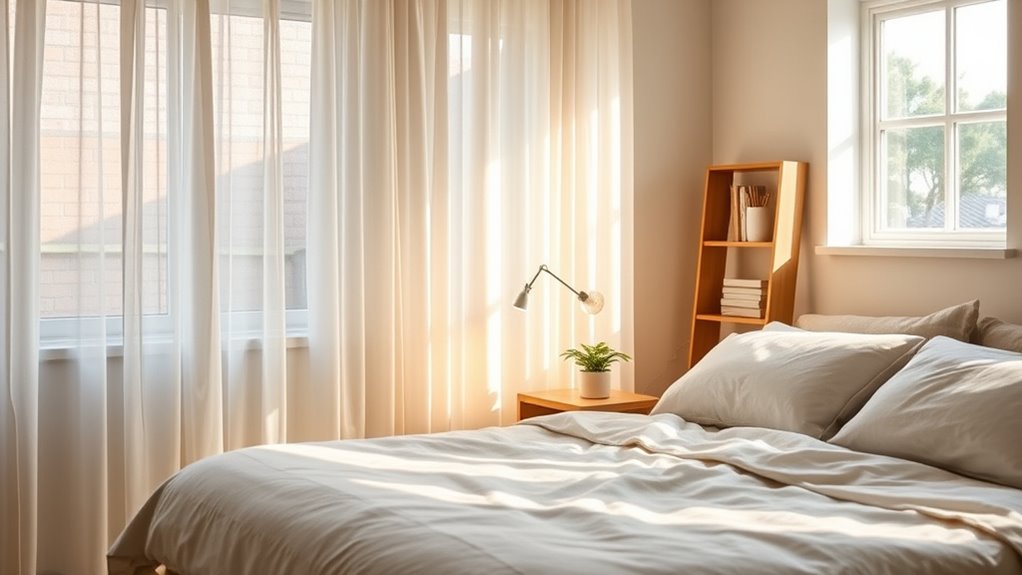
To create a comfortable bedroom environment, start by optimizing your thermostat settings for a cozy temperature. You can also install thermal insulation curtains to help keep the heat in during winter and block out unwanted warmth in summer. These simple changes can greatly enhance your comfort while saving on energy costs. Additionally, consider using an air purifier with HEPA filters to improve air quality, which can contribute to better sleep patterns. Regular air purifier maintenance ensures that your device operates effectively, enhancing the overall quality of your sleeping environment. Engaging in mindfulness practices can also enhance relaxation and promote a more restful night’s sleep. Furthermore, maintaining a proper sun protection routine can help prevent skin damage from sunlight exposure while you sleep if your bedroom has windows that allow UV rays in.
Optimize Thermostat Settings
Here are some tips to help you maintain the perfect temperature while reducing heating costs:
- Set your thermostat to 68-70°F during the day for ideal comfort.
- Lower the temperature when you’re away or asleep to cut down on heating costs.
- Consider a smart thermostat that adjusts automatically, potentially saving you up to 15% on heating costs.
- Use ceiling fans on low speed to circulate warm air effectively, as larger blades move more air efficiently.
- Place your thermostat in a high-traffic area, away from drafts or direct sunlight, to guarantee accurate readings.
Additionally, implementing solar energy solutions can enhance your energy efficiency and contribute to long-term savings on heating bills.
Utilize Thermal Insulation Curtains
When you want to create a cozy and energy-efficient bedroom, utilizing thermal insulation curtains is a smart choice. These thermal curtains can reduce heat loss by up to 25%, ensuring you maintain a comfortable temperature throughout the night. By blocking drafts and minimizing heat transfer, you could enjoy energy savings of up to 15% on your heating bills this winter.
| Benefit | Details |
|---|---|
| Reduced Heat Loss | Up to 25% reduction in heat loss |
| Energy Savings | Potentially 15% off your heating bills |
| Improved Comfort | Reduces noise and creates a cozier atmosphere |
Make sure to properly fit your thermal curtains to the window frame to maximize their insulation benefits.
Laundry Room Energy-Saving Strategies
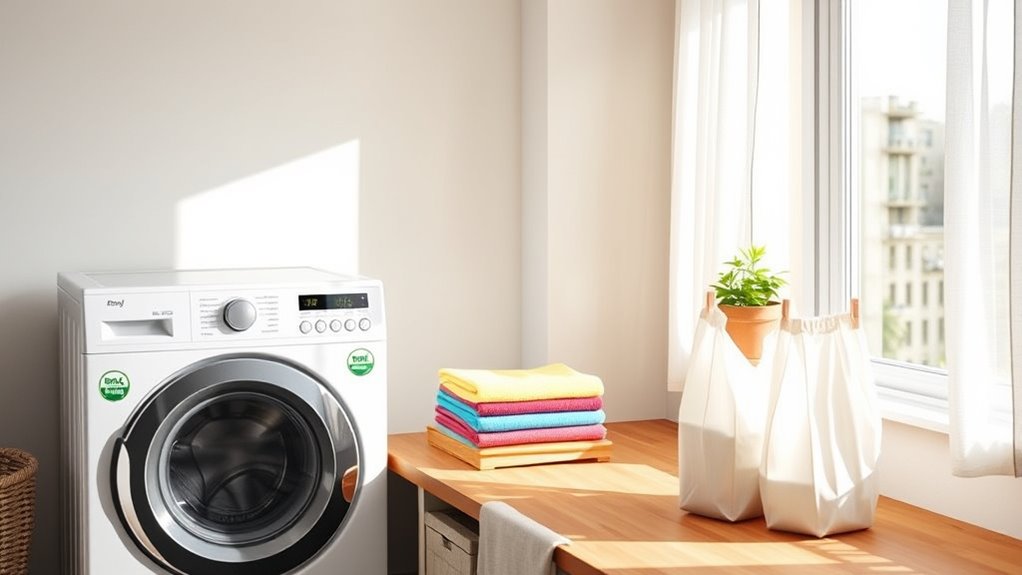
Maximizing energy efficiency in your laundry room is easier than you might think.
Implement these Energy-Saving Tips to help you save money while washing clothes:
- Use cold water for washing clothes to cut heating costs; about 90% of energy goes to heating water.
- Clean the dryer lint trap after each load to improve airflow and boost efficiency.
- Line-dry clothes when weather permits to save up to 6% of your total household energy use.
- Install Energy Star certified appliances, which use 20-50% less energy and water than traditional models.
- Always wash full loads to maximize energy use per cycle, ensuring you get the most out of your appliances.
With these strategies, you’ll enhance energy efficiency in your home!
Optimizing Energy Use in the Garage

To optimize energy use in your garage, start by sealing any gaps in the doors and walls to keep outside air from sneaking in.
Consider switching to energy-efficient lighting solutions that not only brighten the space but also reduce your energy bills.
Seal Garage Doors
Sealing your garage doors is a simple yet effective way to enhance energy efficiency in your home. By minimizing air leakage, you can considerably lower energy costs by 10-20%.
Here are some tips to help you seal your garage doors effectively:
- Use weather stripping and door sweeps to block drafts.
- Inspect and replace worn seals for peak performance.
- Consider an insulated garage door for better thermal efficiency.
- Regularly check for gaps or cracks in the garage walls.
- Seal any openings with caulking or spray foam.
Taking these steps not only improves your garage’s insulation but also contributes to overall energy efficiency in your home.
Don’t overlook your garage; it’s an essential part of your energy-saving strategy!
Energy-Efficient Lighting Solutions
After ensuring your garage doors are properly sealed, it’s time to focus on energy-efficient lighting solutions that can further optimize energy use in this space.
Start by replacing incandescent bulbs with LED lights, which use about 75% less energy and last up to 25 times longer, leading to significant energy savings.
Consider installing motion-sensor lights that activate only when needed, automatically turning off after a set period of inactivity.
Enhance natural lighting by keeping windows clear and using translucent coverings, reducing the need for artificial light during the day.
For task lighting, opt for high-efficiency fluorescent or compact fluorescent lamps (CFLs) that consume less energy while providing adequate brightness.
Regularly clean fixtures to maximize light output and reduce energy consumption.
Enhancing Outdoor Energy Efficiency
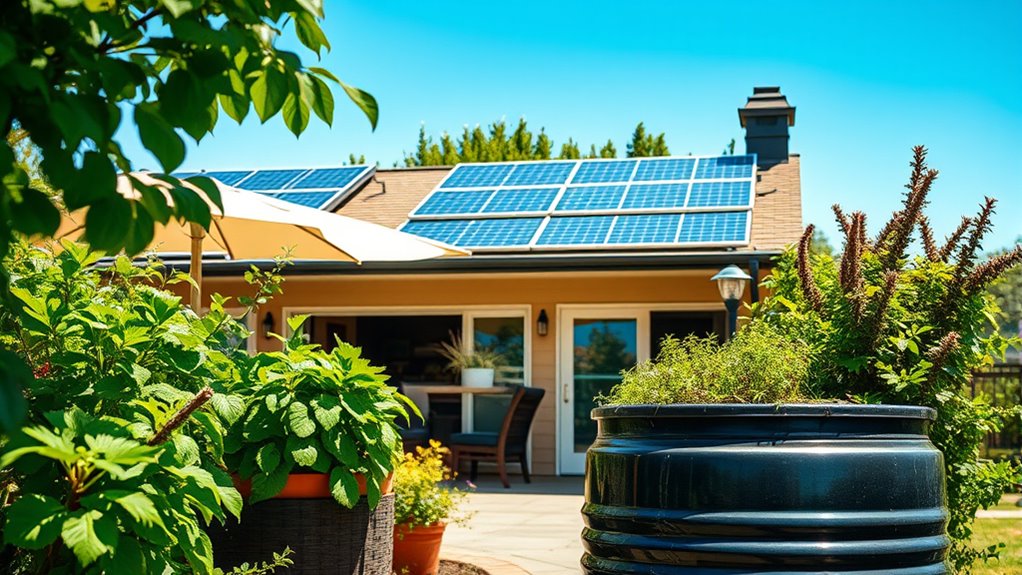
Enhancing outdoor energy efficiency not only reduces your utility bills but also contributes to a more sustainable environment.
Here are some effective strategies to boost your outdoor energy efficiency:
- Install energy-efficient outdoor lighting, like LED bulbs, to cut energy use by up to 75%.
- Use solar-powered garden lights to illuminate your yard without relying on electricity.
- Implement a rainwater harvesting system for water conservation, reducing your landscaping water needs.
- Plant deciduous trees for shade, which can decrease cooling costs by up to 30% in summer.
- Consider permeable paving materials for your driveways and walkways to enhance drainage and reduce energy linked to stormwater management.
These steps won’t only enhance your outdoor space but also promote a greener lifestyle.
General Home Energy-Saving Practices
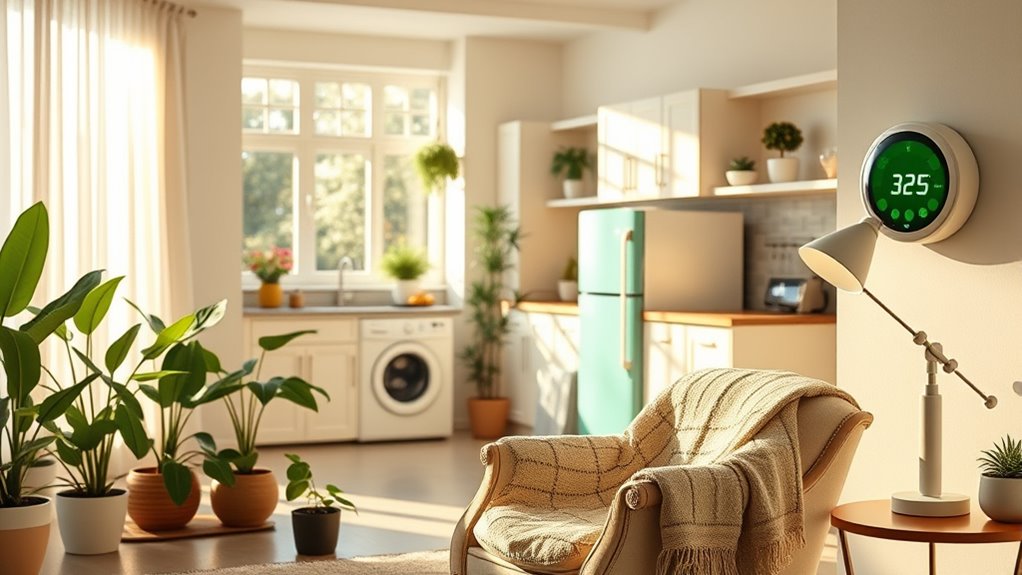
To save energy effectively in your home, it’s essential to adopt a variety of practices that work together harmoniously.
Start by regularly monitoring your energy bills to identify patterns, helping you make informed adjustments. Seal air leaks and invest in energy-efficient appliances to maximize energy efficiency.
Educate everyone in your household about energy conservation practices, creating a community approach to reduce your heating and air conditioning costs.
Schedule annual energy audits to pinpoint hidden energy waste and receive tailored recommendations.
Smart Technology for Energy Management
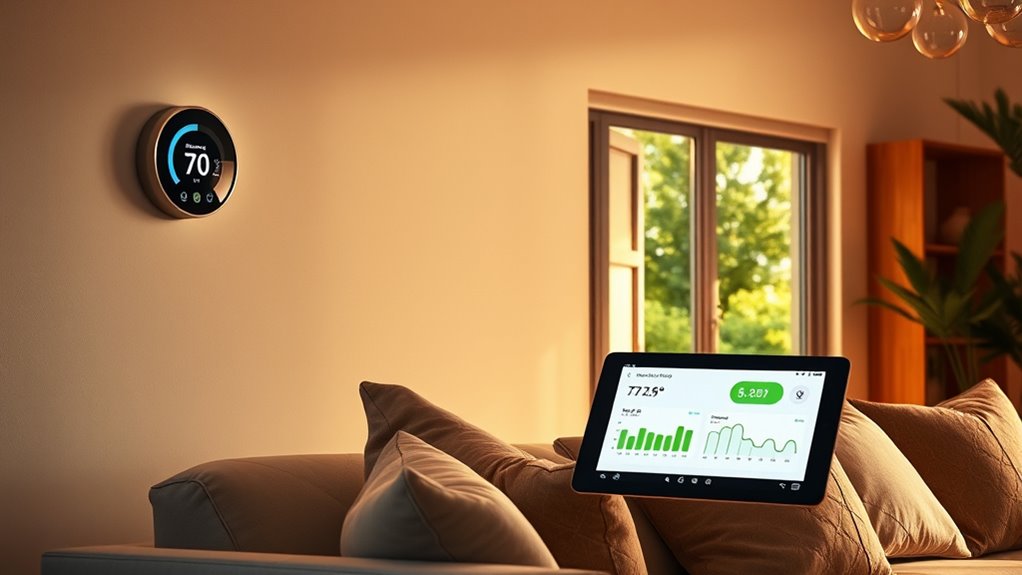
As you look for ways to reduce your energy consumption, integrating smart technology into your home can make a significant difference.
Here are some effective solutions to enhance energy efficiency:
- Smart thermostats: Reduce heating and cooling costs by up to 15% by learning your habits.
- Automated lighting systems: Use dimmer switches and motion sensors to guarantee lights are only on when needed.
- Energy monitoring apps: Track real-time energy usage to identify peak consumption times.
- Smart plugs: Control power to individual devices remotely, managing energy usage even when you’re away.
- Home automation systems: Integrate various energy-efficient devices for optimized performance.
Seasonal Energy-Saving Tips
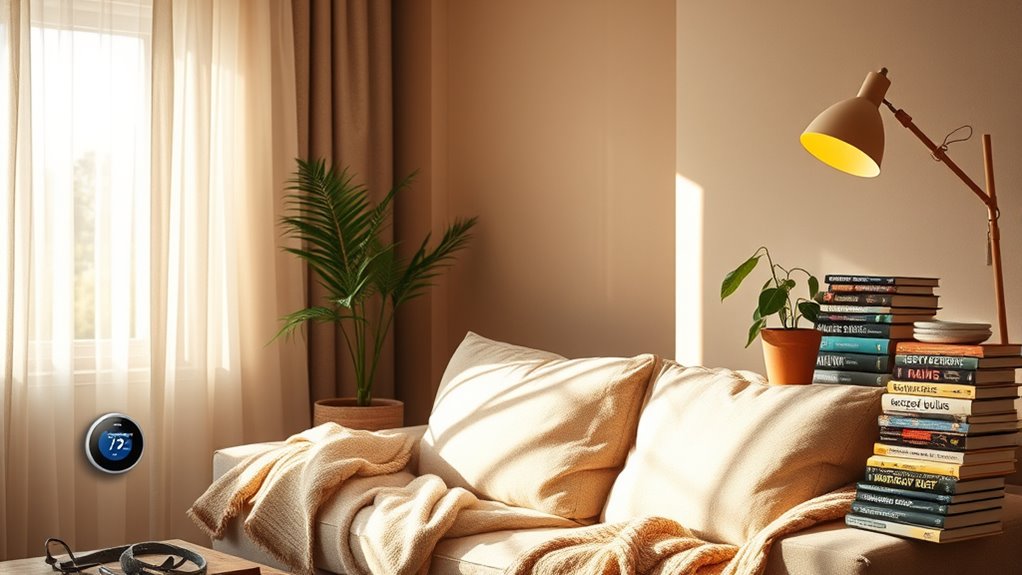
Seasonal changes bring unique opportunities to save energy in your home.
In winter, set your thermostat to 68°F during the day and lower it at night; each degree below 70°F can save you about 3% on heating costs. To maximize heat, open your curtains on sunny days and close them at night, enhancing energy efficiency by up to 10%.
During the summer, use ceiling fans to feel cool while raising your thermostat by 4°F, noticeably cutting air conditioning costs.
In spring and fall, take advantage of natural ventilation by opening windows during cooler parts of the day.
For holiday lighting, switch to LED lights, which use at least 75% less energy than incandescent bulbs and last 25 times longer.
The Importance of Regular Maintenance
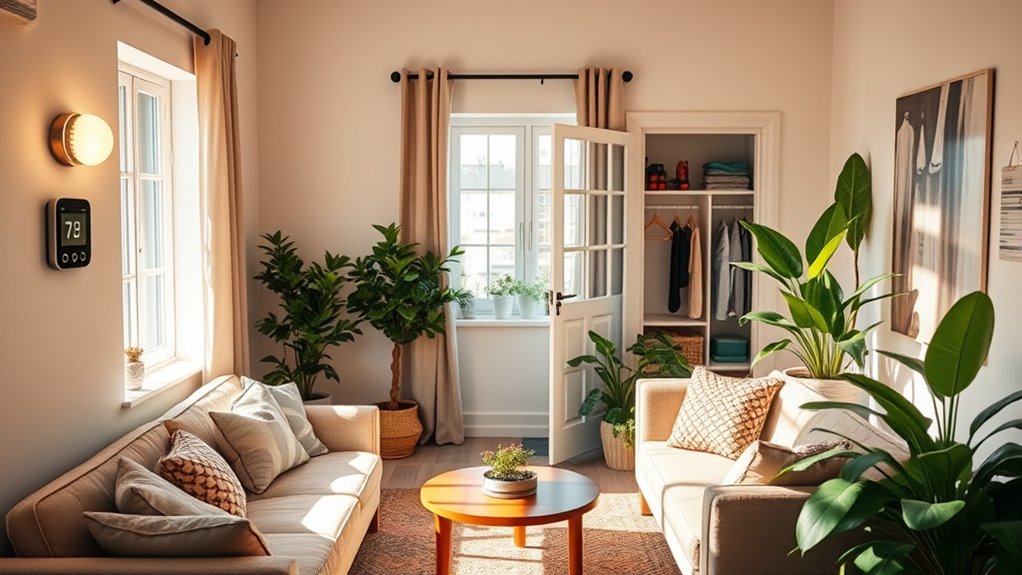
While many homeowners focus on energy-saving habits, regular maintenance of your heating and cooling systems is just as essential.
By ensuring these systems run efficiently, you can use less energy and help keep your home comfortable. Here are some key maintenance tips:
Regular maintenance of your heating and cooling systems boosts efficiency, reduces energy usage, and enhances home comfort.
- Change furnace and heat pump filters every three months for ideal airflow.
- Schedule annual servicing of HVAC systems to catch issues early.
- Clean appliance vents regularly to prevent clogs that increase energy usage.
- Maintain a clean water heater, flushing it to reduce sediment buildup.
- Keep an eye on changes in home energy bills to spot potential problems.
These steps can greatly improve your home’s efficiency, lower energy costs, and extend the lifespan of your systems.
Frequently Asked Questions
What Saves the Most Energy in a House?
To save the most energy in your house, focus on your heating and cooling systems, as they account for about 50% of energy usage.
Regularly maintain these systems, ensuring they run efficiently. Upgrading to energy-efficient appliances, sealing air leaks, and switching to LED lighting can also lead to significant savings.
What Are the Top 10 Ways to Save Energy?
Think of your energy use like a leaky bucket—if you don’t patch the holes, you’ll waste resources.
To save energy, start by lowering your thermostat to 68°F, upgrading to LED bulbs, and sealing air leaks around doors and windows.
Use ceiling fans to circulate air and run large appliances during off-peak hours.
You can also invest in energy-efficient appliances, which will help you keep your bucket full while minimizing waste.
How to Lower Xcel Bill?
To lower your Xcel bill, start by adjusting your thermostat; keeping it at 68°F while you’re home can notably cut costs.
Regularly maintain your HVAC system, replacing filters every three months.
Seal air leaks around windows and doors to prevent energy loss.
Shift the use of major appliances to off-peak hours to take advantage of lower rates.
Finally, consider investing in a smart thermostat for added automation and efficiency.
How to Keep AC Bill Low in Summer?
To keep your AC bill low in summer, set your thermostat to 78°F or higher.
It might seem warm, but each degree above 72°F saves you 3-5% on cooling costs.
Use ceiling fans to help you feel cooler and consider closing blinds during the day to block out heat.
Don’t forget to clean or replace your HVAC filters every three months to maintain efficiency and schedule annual maintenance for peak performance.
Conclusion
By making small changes in each room, you can greatly reduce your energy consumption. Did you know that the average household can save up to 25% on energy bills just by implementing energy-efficient practices? From using LED bulbs to optimizing appliance usage, every effort counts. So, take these tips to heart, and start transforming your home today. You’ll not only save money but also contribute to a greener planet for future generations.
